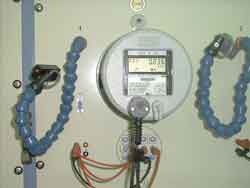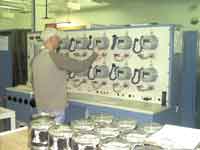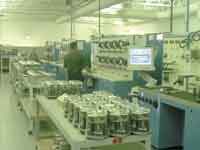
The automation of the meter-reading function is one of the most long-heralded ideas in the energy industry and so a cynic may well ask, “Why should this change now?” In my view the answer lies in the fact that the necessary precursors are only just coming into existence, namely:
- competition among carriers in the supply of transmission links,
- the willingness of utilities to consider outsourcing data management,
- improvements in electronics.
Seventeen years ago only the local telephone companies could offer the ubiquitous coverage (or “footprint”) that is required in order to link all the metered sites of a major power utility to its centralized data management centre. Today, from virtually any location in North America, data can be transmitted via a minimum of four and, more typically, eight to twelve distinct communications networks. The following is but a partial list: the local telephone company, two to four cellular companies, the cable company, a half-dozen paging companies, and three operators of low-level orbiting satellites; and there are more to come. At the urging of electronic equipment manufacturers, a number of electric utilities are considering whether to join the fray using the power line itself to provide the “last-mile” link.
As well as stimulating the willingness of the carriers to negotiate prices, this competition has lead to a more open attitude as to how their network may be utilized. Except in a small number of very
high-density or high-value locations, it is not desirable to tie up dedicated circuits or channels. In fact, the amount of data and frequency of transmission needed to monitor a typical house or commercial location would not use the billionth part of the transmission capacity of something as prosaic as a full-time dedicated telephone line. Telephone, wireless and cable networks have similar problems. All of these carriers rely on the existence of telemetry to control routing and other features of their networks. To do so they have overlaid signalling protocols that operate separately from the transmission of other content. Because of competition, carriers are starting to open these signalling capabilities to third parties. Thus, telephone companies are gradually deploying Utility Telemetry Service protocols. Cellular companies are offering the excess capacity on their out-of-band signalling (or “control”) channels as an alternative to tying up a conventional channel. Without these developments, it would be impossible to deploy a cost-effective bi-directional multi-media network.

Most utilities were formed in an environment where the absence of any infrastructure meant that most things had to be done in-house. In the absence of a monopoly régime, this burst of infrastructure development could not have been financed. Other forms of infrastructure (such as gas, telephone, water and cable) came into being in much the same way. To a degree, these overlapping infrastructures created opportunities for co-operation such as in meter reading or site maintenance. However, in the absence of competition, there was little compulsion to restructure.
Competition, while stressful, has had certain salutary effects. Each utility must re-evaluate every function and determine dispassionately whether it can best be accomplished by itself or others. Often the conclusion is that specialized functions should be carried out by specialized companies. However, the objectives and the approach taken to outsourcing vary widely from case to case.
The capabilities of electronics continues to double every eighteen months, a “law” first postulated by Moore, one of the founders of Intel. However, even a decade ago the capabilities were quite
adequate to perform meter-reading and site-monitoring functions. Of much greater significance are the following considerations:
- the cost of electric components,
- the consumption of power,
- the availability of multiple supplier/integrators.
Cost of Electric Components
The devices being contemplated are, at their heart, what is known in the telephone industry as “autodiallers”, devices that can store information and be prompted by a specific event or the passage of time to access a network and begin communications. Fifteen years ago devices such as these were used extensively in the long-distance industry and cost approximately $700 each. Though largely supplanted now by other technologies, similar devices today can be acquired for under $100. The cost of electronics is no longer a barrier to automation.
Consumption of Power
Until recently the amount of power consumed by electronics was a major problem. At issue, of course, is the ability to perform all the required functions for prolonged periods of time in the absence of external power. Power supplies are one of the more expensive and trouble-prone of electrical components and, except under special circumstances, battery backup is economically out of the question. However, the greater power efficiency of electronics, coupled with lower costs of non-battery energy storage devices, means that solutions are at hand. Indeed, a number of manufacturers have automated meter-reading devices that are FCC-licensed interconnection devices. Among other things, this means that they can even draw their power, measured in micro-amps, from telephone circuits if necessary.

Multiplicity of Suppliers
A decade ago most of the advanced automated meter-reading devices were being developed by start-up companies. There are today a growing number of manufacturers of these devices and, increasingly, very large corporations with extensive development and field support capabilities have become involved in the sector. This does not mean that the buyer can close his eyes and pick. The development and refinement of functional specifications, the creation of software and hardware test beds, the use of field trial protocols, and so forth, must still take place. However, the presence of major, well-capitalized suppliers is a very positive development.
About the Author
Mr. Jan Peeters is Chairman, President and CEO of Olameter Inc., Canada’s largest independent meter service company. He was previously founder, Vice-Chairman, President and CEO of Fonorola Inc., a leading Canadian facilities-based long distance and data services provider. Mr. Peeters obtained degrees in Engineering and Accounting from McGill University (Mining, ’73; CMA, ’84). He is a Governor of McGill University, and a member of the following boards: Cogeco Inc., Intersil Corporation and MSBI Inc.







